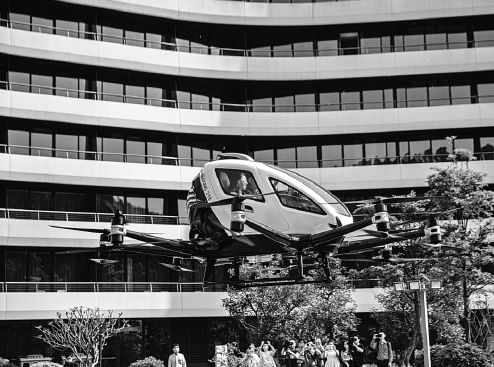EHang seeks to be 1st to land air taxis in China
Guangzhou-based tech firm eyes global AAV commercial operation in H2 of 2022
EHang Holdings Ltd, a leading technology company in autonomous aerial vehicles, or AAVs, is beefing up efforts to promote the commercial operations of passenger-carrying autonomous air taxis and expand its footprint in the global urban air mobility industry.
As an electric vertical takeoff and landing developer, EHang aims to be the first company to launch commercial AAV operations globally, which is likely to happen in the second half of this year, said Edward Xu, EHang's chief strategy officer.
The Guangzhou, Guangdong province-based company plans to develop 100 air mobility routes with a focus on the Guangdong-Hong Kong-Macao Greater Bay Area in the initial stage, and will gradually expand to other parts of the nation, Xu said.
It has carried out aerial tours and short-distance air traffic trial operations from nine operating points, including Guangzhou, Shenzhen, and Zhaoqing in Guangdong province, Hezhou in the Guangxi Zhuang autonomous region, Sanya in Hainan province and some other cities in cooperation with its partners.
Under the relevant compliance framework, the flagship two-seater passenger-grade AAV, the EHang 216, has conducted more than 4,000 trial flights for aerial sightseeing so far.
"The AAVs have a wide range of applications, covering areas such as manned transportation, aerial tourism, aerial logistics, medical emergency response and fire rescue," Xu said.
EHang has established a set of air traffic operating systems and mechanisms that covers route planning, flight operations, safety management, regulatory compliance as well as digital operation platforms, sales and marketing, he said.
In February, the Civil Aviation Administration of China issued special conditions for EHang 216-S type certification, which provides a basis for compliance and safety of EH216-S AAVs, including flight performance, structure, design and construction, propulsion systems, data links and ground control stations, and sets a foundation for airworthiness certification for all AAVs in China.
Looking ahead, EHang hopes to obtain an airworthiness certification for its autonomous aircraft EH216-S as soon as possible, as part of its broader push to promote low-altitude passenger-carrying commercial operations in the urban air mobility, or UAM, sector, Xu said.
A report from Morgan Stanley forecasts that the global urban air mobility market is projected to be worth $1 trillion by 2040 and $9 trillion by 2050.
Xu is upbeat about prospects of UAM, saying electric autonomous air taxis will help solve traffic congestion in metropolises, greatly reduce carbon emissions and improve air quality in urban areas.
"Passenger-carrying AAV, which applies many advanced technologies, is a new area and will boost technological innovation and development for the whole industry," said Pan Xuefei, senior analyst at IDC, a market research firm.
But because of the high safety and performance standards that must be met, such autonomous air taxis will still be subject to strict trials before large-scale commercial operations can begin, Pan said.
Global consultancy Roland Berger estimates there will be up to 3,000 air taxis in operation by 2025 and this figure will increase exponentially to 100,000 by 2050, but a number of technological, infrastructural and legal hurdles remain. For instance, electric vertical takeoff and landing (eVTOL) sites, charging infrastructures and maintenance facilities are among the key enablers for successful operational business models, the consultancy said in a report.
Yu Zhanfu, partner and vice-president of the China unit at Roland Berger, said eVTOL aircraft need to go through full verification regarding safety and technological stability in sparsely populated areas or scenarios, such as natural landscape tourist destinations in the early stage, before they can truly enter the UAM segment.
Compared with traditional helicopters, eVTOL aircraft are smaller, lighter and require less area for takeoff and landing, with lower operating costs, all of which will give a big boost to their popularity. However, they still face technical challenges and uncertainties in various weather and geographical conditions.
EHang is accelerating its globalization push. "We will focus on Asian countries and continue to expand our presence in East Asia and Southeast Asia," Xu said. The company announced on Monday that it had received a preorder for 100 units of EH216 AAVs from Prestige Aviation, an Indonesian aviation company. It is the largest-ever preorder EHang has received for its passenger-grade AAVs in Asia, the company said.
Hu Huazhi, chairman and CEO of EHang, said as the Regional Comprehensive Economic Partnership brings favorable policies to international cooperation, the company will further accelerate the development of UAM in the Asia-Pacific region. The RCEP agreement, which has been in effect since Jan 1, has created the world's largest free-trade bloc.

Passengers take an aerial sightseeing tour in an EHang 216, a two-seater autonomous aerial vehicle, or AAV, in Guangzhou, Guangdong province, in May 2020. CHINA DAILY



 Print
Print Mail
Mail

